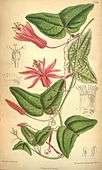Matilda Smith
| Matilda Smith | |
|---|---|
 | |
| Born |
1854 Bombay, India |
| Died | 1926 |
| Known for | Botanical illustration |
| Awards | Silver Veitch Memorial Medal of the Royal Horticultural Society |
| Elected | Linnaean Society |
Matilda Smith (1854–1926) was a botanical artist whose work appeared in Curtis's Botanical Magazine for over forty years.[1] She became the first artist to depict New Zealand's flora in depth, the first official artist of the Royal Botanic Gardens at Kew, and only the second woman ever elected to the Linnaean Society.[2]
Biography
.jpg)
Matilda Smith was born in Bombay, India, on July 30, 1854, but her family emigrated to England when she was a small child.[4][2] Her interests in botany and botanical art were fostered by her second cousin Joseph Dalton Hooker,[5] whose daughter Harriet would also go on to become a botanical illustrator.[4] Hooker was then the director of Kew Gardens and a talented draughtsman in his own right, and he brought Smith into the Gardens to train as an illustrator.[2][6][7]
Smith especially admired the work of Walter Hood Fitch, who was then the lead artist for Curtis's Botanical Magazine.[4] Despite her limited artistic training, Hooker encouraged her to show the magazine her own work, and in 1878 it first published one of her drawings.[4] A dispute over pay between Fitch and Hooker—for whom Fitch had been preparing illustrations for several books—led to Fitch leaving the long-running magazine in 1877. One consequence was that Smith rapidly became a key illustrator at the magazine, at first working alongside Thiselton-Dyer.[2][8] In the period 1879–1881, each issue included some 20 of her drawings, and by 1887 she was almost the sole illustrator for the magazine.[2][5] In 1898, she was appointed the magazine's sole official artist.[4] Over the forty-odd years between 1878 and 1923, Smith drew more than 2,300 plates for the magazine—only 600 fewer than Fitch, although she received much less recognition for this achievement in her own lifetime.[2][6][7][9] As late as the mid 20th century, art teacher Wilfrid Blunt, in his book The Art of Botanical Illustration, dismissed her as an artist of inferior skills, praising her faintly for her charm, her work ethic, and her usefulness in creating a record of otherwise unpictured plants.[10][11] In this he follows a pattern first noticeable in the Victorian era of progressively devaluing botany and botanical art as women entered the field professionally.[12] Other authors, however, both now and in her own day, have admired the clarity and precision of her drawing, and her four decades of employment at the center of the British botanical world testifies to a continuing value for her skills.[6]
In the course of Smith's long association with Kew Gardens, she created 1,500 plates for volumes of Icones Plantarum, a monumental survey of Kew's plants then being edited by Hooker.[2] Beginning with Plate 1354, she was the sole artist for this series, with funds being provided to keep her in this role for as long as she chose to do it.[6] She also made reproductions of plates missing from incomplete volumes in Kew's library, and she became the first botanical artist to extensively depict the flora of New Zealand.[2][6] She was especially admired for her ability to create credible illustrations from dried, flattened, and sometimes imperfect specimens.[4][2][6] Her exceptional contributions to Kew Gardens led to her being designated the first official botanical artist of Kew Gardens in 1898. In 1921, the year she retired from Kew, she was named an associate of the Linnean Society—only the second woman to have achieved this honor.[4][2] She was also awarded the Silver Veitch Memorial Medal of the Royal Horticultural Society for her botanical draughtsmanship generally and for her contributions to Curtis's Botanical Magazine in particular.[4][2]
The plant genera Smithiantha (in the family Gesneriaceae) and Smithiella (viz. Smithiella myriantha, a synonym of Pilea myriantha) were named in her honor.
Smith died in 1926 and is buried in Richmond Cemetery.[4]
Publications illustrated by Smith
- Illustrations of the New Zealand flora Vol 1. (1914)
- Illustrations of the New Zealand flora Vol 2. (1914)
| Illustrations by Matilda Smith | ||||||
|---|---|---|---|---|---|---|
|
| Wikimedia Commons has media related to Matilda Smith. |
References
- ↑ Ogilvie, Marilyn, and Joy Harvey. The Biographical Dictionary of Women in Science: Pioneering Lives from Ancient Times to the Mid-20th Century. Routledge, 2003.
- 1 2 3 4 5 6 7 8 9 10 11 Sampson, F. Bruce. "Matilda Smith (1854-1926)". In Early New Zealand Botanical Art. Reed Methuen, 1985.
- ↑ Parker, Lynn, and Kiri Ross-Jones. The Story of Kew Gardens. Royal Botanic Gardens, Kew, 2013.
- 1 2 3 4 5 6 7 8 9 Kramer, Jack 1996. Women of Flowers: A Tribute to Victorian Women Illustrators. New York, Stewart, Tabori & Chang, 1996.
- 1 2 Hemsley, W. Botting. "The History of the Botanical Magazine 1787–1904". In Index to the Botanical Magazine. London: Lovell Reeve & Co., 1906, pp. v–lxiii.
- 1 2 3 4 5 6 "Miss Matilda Smith". Kew Guild Annual Report, 1915.
- 1 2 "The History of Working Women at Kew". Kew Royal Botanic Gardens website. Accessed 2007-09-03.
- ↑ Endersby, Jim. Imperial nature: Joseph Hooker and the practices of Victorian science. University of Chicago Press, 2008.
- ↑ Page, Judith W., and Elise L. Smith. Women, Literature, and the Domesticated Landscape: England's Disciples of Flora, 1780-1870. Vol. 76. Cambridge University Press, 2011.
- ↑ Blunt, Wilfrid, and William Thomas Stearn. The art of botanical illustration: an illustrated history. Courier Corporation, 1950.
- ↑ Horwood, Catherine. Women and Their Gardens: A History from the Elizabethan Era to Today. Chicago Review Press, 2012.
- ↑ Jackson-Houlston, Caroline. "'Queen Lilies'?: The Interpenetration of Scientific, Religious and Gender Discourses in Victorian Representations of Plants". Journal of Victorian Culture 11.1 (2006) 84-110.
- ↑ IPNI. M.Sm.


